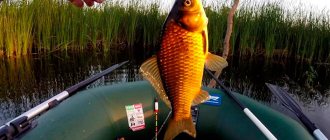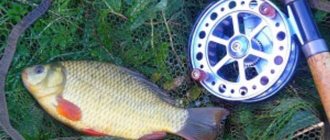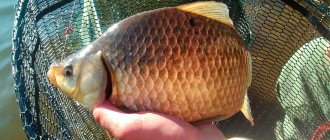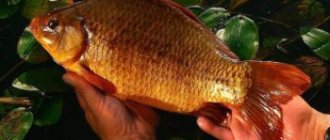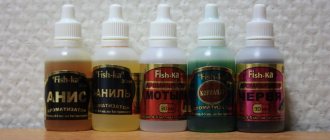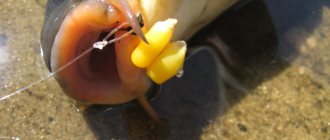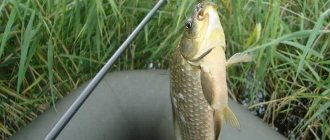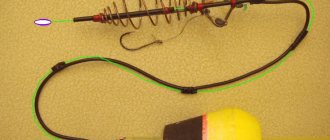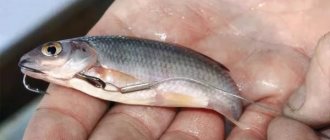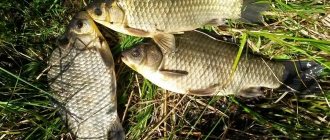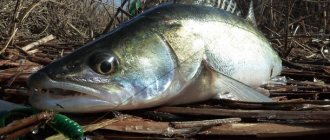Crucian carp is a fish known to everyone and loved by many. Some people think that crucian carp fishing is as simple and straightforward as possible, and there are no special questions in it - you just need to put a worm on the hook and throw the equipment somewhere. But in reality, of course, there are quite a lot of nuances in crucian carp fishing that you need to understand in order to get good catches in a variety of conditions. And one of the important points is the choice of depth for fishing.
Which bottom does crucian carp prefer?
This fish prefers to stay on the muddy bottom. Digging into it, she easily finds food for herself - for example, bloodworms and other insect larvae. There are two disadvantages to silted areas:
- For the inhabitants of reservoirs, the disadvantage is that in such places there is quite a bit of oxygen - much less than on a sandy or rocky bottom. But for crucian carp this does not matter much. This fish is not at all picky about the oxygen content in the water.
- The second disadvantage of fishing on a silty bottom, which is important only for the fisherman, is that equipment with bait can easily “drown” in it, becoming inaccessible to fish. But it’s not difficult to avoid this, you just need to use the right installations.
Thus, it is in silted areas that you should look for crucian carp in the first place. Fishing here brings the best results.
Crucian carp fishing often takes place on a sandy bottom. This fish also chooses such areas quite willingly. But in terms of attractiveness for crucian carp, the sandy bottom is inferior to the muddy bottom. But it’s easier to catch here. The hook with bait is guaranteed not to go into the ground, regardless of what equipment is used.
You can rarely find crucian carp on a rocky bottom. Here this fish is a rare guest and does not stay long. It is not purposefully caught in rocky areas.
This video talks about where to look for crucian carp in the river, the characteristics of its habitats and migration cycles:
At what depth to catch crucian carp depending on the season
From spring to autumn, the behavior of crucian carp and the areas it chooses for feeding change quite a lot.
Spring
Spring is the time of year during which this fish moves most throughout the reservoir, changing the depth of its sites.
Before spawning
In the first half of spring, before spawning, the water is still cold. Therefore, the crucian carp comes out to feed in shallow waters. In areas with minimal depth, the water is well heated by the sun. Here various benthic invertebrates are maximally animated. Fish also come here to feed, a wide variety of fish - from small fry to predators that prey on other scaly animals.
Crucian carp spawning
Crucian carp is no exception. In the first half of spring, before spawning, it willingly feeds at the shallowest depths - from 0.5 m, 1 m, 1.5 or 2 m. This is where you should look for it first. In such shallow waters you can always find quite a lot of active crucian carp, which are looking for food with all their might and therefore get hooked one after another. At the same time, those fish that are not yet feeding or feeding little remain in the pits.
Attention! Large crucian carp almost always prefer to stay at depth. This is also true for spring. If you want to catch trophy specimens, at this time you need to look for them at depths of at least 1 to 2 m, or more likely from 1.5 to 2 m.
After spawning
After spawning, the crucian carp seems to wander around the pond. You can successfully catch it at this time in shallow, medium, and great depths. If you are interested in trophy fishing, you need to look for fish in the pits. Medium and small specimens feed under the shore and at a short distance from it, that is, at shallow and medium depths.
Summer
In summer, crucian carp, depending on the situation, can be caught well at small, medium or large depths.
The fish go to the pits to feed in the heat, at the height of summer. At small and medium depths at this time, the water is heated too much by the sun, and it becomes uncomfortable for it to be here.
Attention! If the heat lasts for a long time, a week, two or more, and the water temperature rises too high even in the pits, the fish rises to the surface to “get some air.” But at the same time, it does not feed, and it is useless to catch it.
Areas with shallow depths in summer are a good option for night fishing for crucian carp. In the dark, the fish come close to the shore to feed, and you can get excellent catches using the simplest light fly rod. Moreover, among the trophies there may be specimens weighing half a kilogram, a kilogram, or even more. True, the situations on different bodies of water in different regions vary greatly, and such productive night fishing is not available everywhere.
Medium depth is a “universal option” for summer fishing. Here crucian carp are caught throughout the summer, both in warm and cool weather; it can be a small fish or good large specimens.
Autumn
With the end of summer, crucian carp move away from the shores, to maximum depth. This is where you should look for it in the fall. The fish are fattening up and preparing for the winter, which will take place here, in the pits. You can look for it at shallow depths under the coast only in early autumn.
At this time, crucian carp still largely adheres to summer habits. On fine sunny days, it can go to shallow waters, where the water warms up well. But catching it in such places in the second half of autumn is a completely futile endeavor.
At great depths
The concept of great, and especially very great depth, is very relative. On some bodies of water, local fishermen consider 6–8 meters deep to be deep; on others, such as Valdai Lake or Stroginsky Quarry, deep depth begins at 12–15 meters.
For anglers who are accustomed to fishing with a jig from a depth of up to five meters, technical problems usually begin from a depth of eight meters.
Let's figure out what this is connected with. Let me start with the fact that a fishing line, even the so-called “sinking” one, has a density very close to the density of water, so the bait itself, in the form of a jig, with or without bait, lowers the bait to the bottom. As the length of the fishing line increases, the frictional force between the fishing line and the water increases proportionally. Experienced lovers of catching, for example, white bream in reservoirs, when it sticks to depths of 12 meters or more and takes it very carefully, know very well what it means to “shove” a jig. The last two or three meters of fishing line have to be literally pushed into the water. It would seem that the solution is very simple - you need to take a heavier jig and a thinner fishing line. But there are many nuances.
Firstly, a heavier jig will also be larger. If you're after big fish, a big jig with a big bait makes a lot of sense. But now the period of the first ice is almost over. Very soon, bream, large roach and perch will leave the middle depths and move to the deep edges and places near the exits to the “slides”. After the end of the first ice, perch and roach will move between shallow waters, “navels” and deep edges.
Fishing on Lake Valdai is very indicative in this regard. Almost throughout the winter (thanks to the excellent oxygen conditions), roach, large perch and even bream can be periodically found at depths of 2–3 meters. But fishing on slides with a depth of 7–9 m is more effective. For Valdai Lake these are slides, since they are surrounded by depths of 18–30 m. But very often roach can already be found only at a depth of 14–18 m.
The thicker the ice becomes, the more often even large fish begin to refuse large bait. You have to resort to using “sports” tackle with a thin fishing line and a small jig.
Fishing is complicated by the fact that when searching for fish you have to examine places with depths of both 3 and 12 meters or more. That is, there must be several gears, at least three. On the most “non-biting” days you have to look for fish with only the thinnest tackle. But such a tactic can very likely lead to the fact that the very first bite will lead to the breakage of the tackle.
Now about the thickness of the fishing line. A thin line goes into the hole much faster, but may not withstand the resistance of a large fish brought to the hole, and will not allow for effective hooking when catching, for example, pike perch with a jig.
It turns out that it is not possible to create a “universal” tackle, so it is worth analyzing several standard cases of fishing from great depths.
CATCHING BLACKPICK FROM A DEPTH OF MORE THAN 10 M.
In case of active biting, fishermen more often use float equipment designed on a relatively thick fishing line (0.15–0.18 mm) without a leash. The load and float are selected in accordance with the depth. In general, there are no problems with the tackle as long as there is a bite. But when the bite becomes very sluggish, you should resort to a jig.
You need to start with a fishing line, because if you catch fish up to half a kilogram, then you can use a fishing line with a diameter of 0.10 mm, and if you are aiming to catch bream weighing up to three kilograms, then there is no point in taking a fishing line thinner than 0.16 mm. Now about the jig. Depending on the thickness of the fishing line and the depth, a jig of minimum weight is selected.
A tungsten jig with a diameter of 2.5 mm is quite capable of pulling a 0.10 mm fishing line ten meters, but for a fishing line with a diameter of 0.20 mm you will have to use a tungsten jig with a diameter of 5–7 mm. There is nothing wrong with this, since a large fish, in this case bream, is more likely to be tempted by a worm on the hook of a large jig. The biggest problems are with small bream weighing up to 300 g, since the smallest jig with one “moth” on a line of 0.08 mm is most often optimal for catching it. But this is purely sport fishing.
FISHING FOR PERCH AND ROACH FROM GREAT DEPTHS
It is almost always more effective if a jig is used. There is no need to talk about the game of a small bait at such a depth. The jig does not repeat the movements of the nod. The nod oscillates, but due to the resistance of the water and the stretchability of the fishing line, the movements of the jig are not oscillatory, but translational. That is, the jig rises upward with slow jerks. Perch at a depth of five meters and deeper most often takes a jig lying on the bottom or slowly rising to a height of no more than 15 cm from the bottom. It would seem worth using float equipment, but the bites are so careful that the inertia of the float does not allow you to react in time. What’s so good about the jig is that you can instantly see the slightest touch of the fish on the bait.
Interestingly, when fishing for perch, you can use a thinner line than when fishing for roach. So, for example, at one time I very often fished in the Stroginsky quarry from depths of 7 to 12 meters and came to the conclusion that for perch a line with a diameter of 0.08 mm (the largest specimen is 720 g) is quite enough, and for roach 400 g Still, it’s better to take a 0.10 mm fishing line.
CATCHING Pike-perch with a jig
Catching pike perch using a jig with bloodworms, “sharp” perch or with replanting “sprat” has become very common, especially in those reservoirs in which there are either relatively few pike perch, or they are experiencing significant pressure from “spinners” and “balancers”. A large jig with a bunch of bloodworms is capable of seducing the most phlegmatic pike perch in the darkest time. The fishing depth is usually great, for example, at Tsimlyanka (a quarry connected to the Oka River), the working depths when searching for pike perch range from 8 to 14 m. A large tungsten jig with a strong hook No. 4–8 is successfully used as bait here. The important thing is that the pike perch’s mouth is hard and a corresponding “hard” hook is required, so either monofilament with a diameter of at least 0.18 mm or “braid” is chosen. The mild winter conditions that have been observed in the Moscow region for several years make it possible to use almost any kind of wicker, whether “summer” or “winter”. It is better to take a rigid monofilament line. It is the rigidity of the fishing line, and therefore the quality of the hook, that plays a decisive role in the realization of bites.
Having considered several options for catching “ordinary” fish from great depths, here I specifically did not mention fishing for smelt and whitefish on Lake Peipsi or fishing for cod opposite the beaches of Jurmala, since “sea” fishing allows the use of coarser gear.
I would like to focus attention not only on the selection of gear, but also on some nuances in fishing techniques. First of all, about hooking. She must be energetic in all cases. Firstly, the transmission of a bite to the bite alarm, that is, to the nod, somehow occurs with some delay. Secondly, any fishing line, even the stiffest one, stretches under load and the hooking force is lost as the fishing depth increases.
When fishing for bream, roach and perch, which have soft lips, it is not at all necessary to use a hard fishing line, since a sharp, thin, but strong hook often serves as the fisherman himself. The fish, having tried the bait, clings with a sharp hook to the soft tissues of the mouth, pulls the equipment, a nod registers the bite, the fisherman makes a “control” hook, and then fishing or pulling out begins - it all depends on the size of the fish and the safety factor of the equipment.
By the way, you need to fish and pull out “wisely.” The most difficult thing to fish for is bream and large roach on a thin line. The fact is that a bream “dragged” for ten seconds from a depth of 15 meters to a hole has enough strength to actively resist directly near the hole. It’s easier with perch; after a few meters of rise, it gives up and usually doesn’t resist in the hole.
A thin fishing line on ice causes a lot of trouble. When taken out of the water, it gets tangled, freezes, and clings to shards of ice. To prevent this from happening, it’s worth recalling one old trick. You lift the rod, grab the line, then grab it again and throw the rod into the wind. Thus, several meters of fishing line lie flat on the ice. You throw the rest of the fishing line towards the fishing rod and it also lies flat, but in rings.
If you are using a fairly thick fishing line, then it makes sense to take a special winter fishing rod with a long whip and guides and equip it with a small inertia-free reel. This is how they catch pike perch and bream. In conclusion, I would like to remind you that fish, as a rule, avoid the deepest places in the reservoir.
Andrey Yanshevsky January 8, 2008 at 15:23
Depth for catching crucian carp depending on the reservoir
Much depends on the nature of the reservoir and its features. So, in shallow ponds and lakes (with depths up to 2 m), crucian carp should be looked for at the bottom. There is nothing to catch in the middle and upper layers of water. In such reservoirs, it is always better to choose the maximum bait depth, except perhaps in the spring.
If there are cold springs at the bottom of the reservoir, and the water temperature in the bottom layer is lower, this fish usually stays on the border of the cold and warm layers or higher, already in a well-warmed horizon.
Choosing the depth for fishing for crucian carp in such lakes and rivers is quite difficult. You need to either use a good echo sounder or video camera that can show what horizon the fish is on, or select this horizon experimentally, making test casts with different bait releases.
If there are food competitors for crucian carp in a reservoir - usually carp and tench - it often prefers to stay higher, in the middle layers of water or near the surface. On such ponds and lakes it is often necessary to set up the equipment so that the bait sinks to a depth of 10-20 cm and no more. This approach brings the best catches of this fish here.
Thus, choosing the depth for catching crucian carp is not as simple a task as it might seem at first glance. Sometimes this fish stays close to the shore, in shallow water, and sometimes, on the contrary, it goes closer to the middle of the reservoir. Also, crucian carp can choose different horizons - look for food at the bottom, in the middle layers or under the very surface. But, if you know the basic rules for choosing the depth for catching it and experiment more, placing the equipment at different points and setting different bait releases, success is guaranteed.
In summer
For example, in the context of this statement, one can easily explain the movements of carp following the wind in the summer season. Since at this time of year, in virtually all bodies of water on Earth, there is a “deficit” of oxygen. As a rule, it occurs due to the increased growth of underwater plants and an increase in the number of a wide variety of bottom organisms that require it (i.e., oxygen) for normal life.
So, the water, closer to the shore, will always be more “oxygen” than any other areas of the reservoir. That is why, according to the results of many observations, it turned out that most often, carp prefer to be near the windward coast (only safe from pressure and well warmed up). This also means that the fish will definitely “check in” at shallow depths (or simply in the upper layers of water) in order to consume oxygen in the amount it needs. Another, no less important “magnet” for carp in these places will be a large amount of fresh and tasty food blown from the land by the wind.
